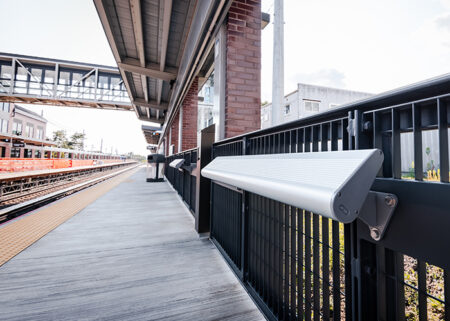'Hostile architecture', also known as 'anti-homeless' design, makes public spaces less welcoming for everyone, including older people.Are there fewer places to sit around town than there used to be? Perhaps you’ve noticed that some of the benches at your local train station have been replaced by angled ‘leaning rails’. You may have even seen metal studs or spikes appearing on ledges and low walls in public spaces. These are all examples of a style of urban design known as ‘hostile architecture’.
What is hostile architecture and who is it hostile towards?
Hostile architecture is an approach to designing public places that aims to deter certain types of activity. Usually, this means making it harder, less comfortable or less safe for homeless people to stay in an area. For this reason, hostile architecture is also known as ‘anti-homeless’ architecture.
Public spaces are already unwelcoming to homeless people. Whether it’s because of over-policing, targeted violence and harassment, a lack of adequate services or simply the cruel reality of not having a home, life for people experiencing homelessness can be incredibly difficult and punishing. Yet the people who design our public spaces often seek to add to this struggle by removing spaces where homeless people can rest, stay safe or shelter from the elements.
Hostile architecture can take many forms. As mentioned above, it often involves removing places to sit or lie down, such as benches or ledges. It can also mean making these surfaces inhospitable or less comfortable, such as by making ledges angled, by adding sharp concrete spikes under bridges or other shelters, or by adding metal armrests in the middle of long benches so that they cannot be slept on.
Some councils also play loud music at certain times of the day or night to deter homeless people from sheltering in various locations. Bunbury Council in Western Australia previously played ‘The Wiggles’ around a local landmark to keep people from sleeping nearby, before the band intervened to request their music not be used for such a cruel purpose.

Older people are also impacted
It would be bad enough if these strategies only impacted people experiencing homelessness, but hostile architecture makes public spaces less welcoming for the entire community. For older people in particular, these strategies result in the loss of places to comfortably sit and rest or to wait for a train or bus.
They can also create the sense that public spaces are not meant to be experienced and enjoyed but should instead only be used for commerce and thoroughfare. In other words, it can make people feel like they cannot stay in a space, they can only move through it to get somewhere else. This can make older people feel less safe and comfortable in their communities and can increase the impact of social isolation.
If you are struggling to find a seat at your local train station or bus stop, or if you can’t sit and enjoy the sights and sounds of your local community, there’s a good chance that hostile architecture is to blame.

What can be done about it?
We are in the midst of a cost-of-living crisis and a housing crisis in which more people are experiencing housing insecurity and becoming at risk of homelessness. Hostile architecture does nothing to solve homelessness, it just forces homeless people away from certain areas. If Councils and State Governments want to actually address the problem, they need to build more high quality and accessible public housing throughout Australia. State Governments should also protect people from unfair evictions and unaffordable rental increases.
The Australian Government can help by increasing funding to the States for public housing, and by raising the rate of all income support payments to reduce the risk of people becoming homeless in the first place, and to assist homeless people in accessing temporary and permanent accommodation.
We can also all play a role in letting decisionmakers know that we will not tolerate hostile architecture in our communities. If you notice the removal of public seating in your neighbourhood, or the installation of spikes on walls, windowsills and ledges, lodge a complaint with your local council to voice your disapproval.
If the seating at your local train station or bus stop has been removed or replaced with a ‘leaning rail’, you can make a complaint to Transport for NSW.
Public spaces are for everyone. Their designs should reflect that.
Are there fewer places to sit around town than there used to be? Perhaps you’ve noticed that some of the benches at your local train station have been replaced by angled ‘leaning rails’. You may have even seen metal studs or spikes appearing on ledges and low walls in public spaces. These are all examples of a style of urban design known as ‘hostile architecture’.
What is hostile architecture and who is it hostile towards?
Hostile architecture is an approach to designing public places that aims to deter certain types of activity. Usually, this means making it harder, less comfortable or less safe for homeless people to stay in an area. For this reason, hostile architecture is also known as ‘anti-homeless’ architecture.
Public spaces are already unwelcoming to homeless people. Whether it’s because of over-policing, targeted violence and harassment, a lack of adequate services or simply the cruel reality of not having a home, life for people experiencing homelessness can be incredibly difficult and punishing. Yet the people who design our public spaces often seek to add to this struggle by removing spaces where homeless people can rest, stay safe or shelter from the elements.
Hostile architecture can take many forms. As mentioned above, it often involves removing places to sit or lie down, such as benches or ledges. It can also mean making these surfaces inhospitable or less comfortable, such as by making ledges angled, by adding sharp concrete spikes under bridges or other shelters, or by adding metal armrests in the middle of long benches so that they cannot be slept on.
Some councils also play loud music at certain times of the day or night to deter homeless people from sheltering in various locations. Bunbury Council in Western Australia previously played ‘The Wiggles’ around a local landmark to keep people from sleeping nearby, before the band intervened to request their music not be used for such a cruel purpose.

Older people are also impacted
It would be bad enough if these strategies only impacted people experiencing homelessness, but hostile architecture makes public spaces less welcoming for the entire community. For older people in particular, these strategies result in the loss of places to comfortably sit and rest or to wait for a train or bus.
They can also create the sense that public spaces are not meant to be experienced and enjoyed but should instead only be used for commerce and thoroughfare. In other words, it can make people feel like they cannot stay in a space, they can only move through it to get somewhere else. This can make older people feel less safe and comfortable in their communities and can increase the impact of social isolation.
If you are struggling to find a seat at your local train station or bus stop, or if you can’t sit and enjoy the sights and sounds of your local community, there’s a good chance that hostile architecture is to blame.

What can be done about it?
We are in the midst of a cost-of-living crisis and a housing crisis in which more people are experiencing housing insecurity and becoming at risk of homelessness. Hostile architecture does nothing to solve homelessness, it just forces homeless people away from certain areas. If Councils and State Governments want to actually address the problem, they need to build more high quality and accessible public housing throughout Australia. State Governments should also protect people from unfair evictions and unaffordable rental increases.
The Australian Government can help by increasing funding to the States for public housing, and by raising the rate of all income support payments to reduce the risk of people becoming homeless in the first place, and to assist homeless people in accessing temporary and permanent accommodation.
We can also all play a role in letting decisionmakers know that we will not tolerate hostile architecture in our communities. If you notice the removal of public seating in your neighbourhood, or the installation of spikes on walls, windowsills and ledges, lodge a complaint with your local council to voice your disapproval.
If the seating at your local train station or bus stop has been removed or replaced with a ‘leaning rail’, you can make a complaint to Transport for NSW.
Public spaces are for everyone. Their designs should reflect that.
